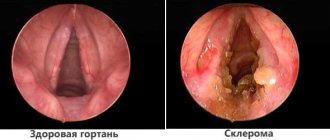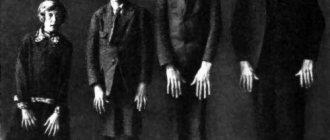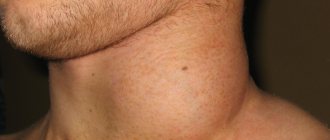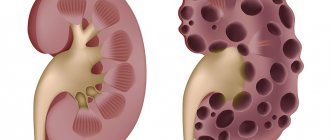Arnold-Chiari syndrome is an anomaly of brain development in which those parts of the brain that are located in the posterior fossa of the skull are lowered and protrude through the foramen magnum. This syndrome can be accompanied by severe occipital pain, nystagmus, dizziness, blurred vision and hearing, as well as a number of other unpleasant symptoms. Disturbances that occur with Chiari malformation are associated with the functioning of the cerebellum and medulla oblongata. As a result, the syndrome affects the respiratory system and central nervous system, having an extremely negative impact on the functioning of the heart.
What is Arnold-Chiari syndrome?
In the presence of the syndrome, displacement of the cerebellum is observed
The foramen magnum is located where the skull connects to the vertebral column. This is where the spinal cord connects to the brain. Just above this opening in the skull there is a posterior fossa, where the cerebellum, pons and medulla oblongata are located.
During normal brain development, the cerebellum is located slightly above the foramen magnum. When pathology occurs, the cerebellar tonsils descend into the lumen of the foramen, putting pressure on the medulla oblongata located underneath them. This disrupts the normal circulation of cerebrospinal fluid, which triggers the development of hydrocephalus.
Arnold-Chiari syndrome is considered a rare disease. According to statistics, per 100 thousand people there are only 5-8 patients with this disease. ICD-10 disease code: Q07.0.
Pathology is often detected in newborns. The reason for this is the presence of negative factors affecting the development of the fetus during pregnancy. The pathology can also be detected in an adult, and often the deviation is diagnosed completely by chance, without manifesting itself in any way before. In the vast majority of cases, Arnold-Chiari syndrome develops together with a serious disease of the nervous system - syringomyelia.
Reasons for the development of pathology
In modern medicine there is no exact data regarding the etiology of this anomaly. At the moment, there are several hypotheses about this in scientific circles:
- Some experts believe that this syndrome is a consequence of underdevelopment of the posterior cranial fossa. If it is of insufficient size, then the structures located in it naturally descend into the foramen magnum as they grow.
- If the brain is enlarged, this can also cause the development of pathology. In this case, the cerebellum, located in the cranial fossa, is pushed out of it by the brain.
- Progression of hydrocephalus. With hydrocephalus, an increase in the cerebral ventricles is observed, and accordingly, the brain becomes larger.
- Due to severe traumatic brain injury, herniation of the cerebellar tonsils into the foramen magnum can also occur.
In addition, a number of factors are known to contribute to the development of Arnold-Chiari syndrome:
- birth injuries;
- malnutrition of a pregnant woman;
- acute infections suffered during pregnancy;
- bad habits of a pregnant woman and her uncontrolled use of medications.
Features of the pathology
Arnold-Chiari syndrome in the fetus during pregnancy
There are 4 types of Chiari disease:
- The first type involves slight prolapse of the tonsils. They occupy a position just below the occipital foramen. As a rule, this pathology is present in adolescents and adults. Often accompanied by the development of hydromyelia, when a large amount of cerebrospinal fluid accumulates in the central spinal canal.
- Second type. This form of Arnold-Chiari syndrome develops in the fetus due to the influence of a number of negative factors. This pathology usually manifests itself in a baby almost immediately after birth. In this case, not only the cerebellum passes through the foramen magnum; the medulla oblongata and the fourth ventricle also descend. In most cases, congenital spina bifida is detected in patients simultaneously with this pathology.
- Third type. When the cerebellum and medulla oblongata descend, they enter a herniated brain (meningocele), located in the cervico-occipital region.
- Fourth type. It is not associated with displacement of the cerebellum, but is characterized by its underdevelopment. This type of pathology is often referred to as Dandy-Walker syndrome, characterized by a combination of hydrocephalus, cerebellar hypoplasia and congenital cysts localized in the posterior cranial fossa.
The second and third types of anomalies are often combined with other problems in the development of the central nervous system. We are talking about heterotypy of the cerebral cortex, anomalies of the corpus callosum, hypoplasia of subcortical structures, etc.
Prevention
To prevent the child from having the above problems, the expectant mother must take her situation seriously. Firstly, she must familiarize herself with all possible pathologies that may occur in the fetus: neural tube developmental disorders, Down syndrome, Arnold Chiari anomaly type 1. Every expectant mother should know what these diseases are, why they occur, and what measures can be taken to reduce the risk of developing these and other abnormalities. A competent and informed pregnant woman will avoid as much as possible all those factors that negatively affect the formation of the embryo.
Secondly, a woman is obliged to eat well, eat a variety of healthy dishes: fish, meat, fruits, vegetables, cereals and dairy products. Alcohol is strictly prohibited. In addition, you need to stop smoking, not to mention drugs and potent drugs. The expectant mother takes any medications, even homeopathic ones, only after a doctor’s prescription. Thirdly, a woman should also walk a lot, breathe fresh air, and move a lot. You should forget about nerves, worries and negative emotions, enjoying your position and getting maximum joy from life.
Symptoms
Since the most common type is the first type of Arnold-Chiari malformation, its symptoms should be considered in more detail. This syndrome includes several symptom complexes, namely:
- cerebellobulbar;
- cerebrospinal fluid hypertension;
- syringomyelitic.
Liquor-hypertensive syndrome manifests itself as follows:
- Severe headaches localized in the neck and back of the head. As a rule, they worsen with sneezing and coughing, as well as tension in the neck muscles.
- Vomit. The urge occurs regardless of the type of food and frequency of meals.
- The tone of the neck muscles is increased.
- Cerebellar disorders. These include nystagmus, speech problems, and cerebellar ataxia.
If a patient has damage to the brain stem (cerebellobulbar syndrome), then the following symptoms occur:
- diplopia (double vision);
- swallowing dysfunction;
- deterioration of vision and hearing;
- noise in ears;
- severe dizziness, in which there is a feeling that surrounding objects are rotating around the patient;
- loss of consciousness – short-term, but periodically recurring;
- sleep apnea syndrome;
- laryngeal paresis, accompanied by difficulty breathing and hoarseness;
- atrophy of the tongue (usually unilateral);
- orthostatic collapse.
One of the main symptoms of Chiari syndrome is the occurrence of dizziness when turning the head. Some patients experience fainting.
If this anomaly develops in parallel with syringomyelia, then the following symptoms are added to the above-described signs:
- numbness of the limbs;
- pelvic disorders;
- muscle wasting;
- lack of abdominal reflexes;
- neuroarthropathy.
Features of the manifestation of the syndrome in children
A weak cry, wheezing noisy breathing in newborns are all symptoms of Arnold-Chiari syndrome type 2
In childhood, pathology of the second and third types appears. As a rule, symptoms of these abnormalities appear already in the first days of a baby’s life. The second type of syndrome is characterized by the following symptoms:
- noisy breathing;
- bilateral laryngeal paresis;
- periodic cessation of breathing;
- violation of swallowing function - food is thrown into the nasal cavity;
- nystagmus;
- cyanosis of the skin;
- increased muscle tone in the upper extremities.
There may also be problems with mobility. Such disorders can have varying degrees of severity and progress.
Arnold-Chiari syndrome type 3 is characterized by a number of complications and often leads to fetal death in the womb. When a deviation is detected in newborns, the risk of incompatibility of the pathology with life is also very high.
Complications that the disease can cause
In some cases, Arnold-Chiari malformation can be a very progressive disease and lead to certain complications. They may be:
- Hydrocephalus , which occurs as a result of the accumulation of more than the allowed amount of fluid.
- Paralysis, which may be caused by compression of the spinal cord.
- Syringomyelia, which involves the formation of a cavity or cyst in the spine. After their occurrence, fluid can enter such cavities and lead to disruption of the normal functioning of the spinal cord.
- There may be a disturbance in the respiratory process, which develops until it stops.
- There may be cases of congestive pneumonia, which occurs as a result of the patient losing the ability to move independently.
Diagnostics
It is possible to make a preliminary diagnosis based on a neurological examination and listening to the patient’s complaints. Instrumental diagnostics can show the following results:
- Echo-EG, EEG and REG can detect increased intracranial pressure, which often occurs with Arnold-Chiari syndrome. However, it is impossible to make a definitive diagnosis using these techniques.
- Radiography. This examination of the skull makes it possible to identify bone abnormalities that result in the development of Arnold-Chiari syndrome. Due to the inaccuracy of data, this technique is currently practically not used.
- CT and MSCT of the brain. The methods are distinguished by excellent visualization of bone structures, but do not provide an idea of the condition of soft tissues.
- MRI of the brain. It is this study that provides the most complete results regarding the state of the brain structures located in the posterior cranial fossa.
- MRI of the thoracic and cervical spine. Allows us to identify concomitant abnormalities of the nervous system, which often develop in parallel with Arnold-Chiari syndrome.
Due to the fact that MRI is performed with the patient completely immobilized, when examining small children they are first put into a state of medicated sleep.
Treatment
To eliminate Arnold-Chiari syndrome, painkillers and anti-inflammatory drugs, as well as muscle relaxants, are used
Treatment of the disease depends on the degree of its manifestations:
- If the syndrome is asymptomatic and was discovered by chance, then specific treatment for this pathology is not required.
- If the patient has pain in the back of the head and neck, conservative therapy is used (taking anti-inflammatory drugs, analgesics and muscle relaxants).
- In the presence of neurological disorders that cannot be eliminated conservatively, surgical intervention is indicated. We are talking about problems with sensitivity, paresis, muscle tone disorders, etc.
Features of surgical treatment
The following surgical procedures are used to eliminate Arnold-Chiari syndrome:
- Craniovertebral decompression. This operation involves removing a small fragment of the occipital bone. This allows you to slightly expand the foramen magnum. After this, resection of the cerebellar tonsils and parts of the first two cervical vertebrae is performed. This procedure allows you to normalize the circulation of cerebral fluid and eliminate the symptoms of pathology.
- Shunting. Operations of this type involve drainage of cerebrospinal fluid from the central spinal canal. In this case, it can be diverted into the abdominal or chest cavity.
Symptoms
| Occurrence (how often a symptom occurs in a given disease) | |
| Dizziness | 70% |
| Headache in the occipital region (pain in the back of the head) | 50% |
| Unsteadiness when walking | 40% |
| Difficulty swallowing (dysphagia, difficulty swallowing, swallowing disorder) | 10% |
| Difficulty speaking (speech disorder, speech disorder, speech problems) | 5% |
| Fainting (loss of consciousness) | 5% |
| Numbness of the face | 5% |
| Vomiting of various types, including indomitable | 5% |
| Hearing loss (hearing impairment, hearing impairment, poor hearing) | 5% |
| Unclear pronunciation of sounds | 0% |
| Gradually increasing weakness in the arm muscles | 0% |
Forecast
The prognosis depends on the type of pathology. Chiari malformation type I has a very favorable prognosis and can even be asymptomatic throughout life. Type III syndrome most often quickly ends in death. In other cases, timely surgical treatment is important. The effectiveness of surgical intervention (craniovertebral decompression) ranges from 50 to 85%.
Related Articles
Hydrocephalic syndrome: causes, symptoms, diagnosis, treatment
Brain dislocation syndrome: how dangerous is it and how is it treated?
Guillain-Barré syndrome: symptoms, clinical picture and complications, treatment methods
Wernicke encephalopathy: causes and symptoms, possible complications, diagnosis and treatment
Graefe syndrome: what it is, causes, symptoms, complications, diagnosis and treatment
Apallic syndrome - waking coma: ICD-10 code, causes, symptoms and possible treatments
Risk factors
Everyone knows that during the first trimester of pregnancy, the fetus undergoes the formation of virtually all organs. Therefore, the correct lifestyle of the mother is very important for the normal development of the child. If a woman does not follow basic rules, this causes many complications in the future. As for Chiari syndrome, the following factors increase the risk of its occurrence:
- Mom's bad habits: smoking, alcohol and drug abuse.
- Use of strong drugs, self-medication.
- Past viral infections, especially rubella.
In particularly mild forms of the disease, the born baby does not feel any special symptoms for the rest of his life, especially if he is diagnosed with type 1 Arnold Chiari malformation. How long do children who have the third or even fourth stage of the disease live? Doctors give disappointing prognoses. Unfortunately, such babies are doomed to death in most cases. Even if a baby is diagnosed with the first or second type of illness, he needs treatment: the effectiveness of surgical intervention is 85%.











